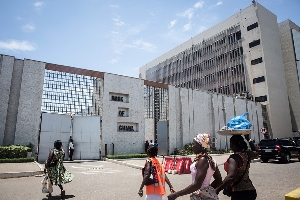Good morning, Ladies and Gentlemen of the Media and welcome to the press briefing for the 117th Monetary Policy Committee (MPC) meetings which took place last week. The Committee deliberated on global and domestic macroeconomic developments, including assessment of the performance of the economy and the risks to the outlook for inflation.
A summary of the assessments and key considerations that informed the Committee’s decision on the positioning of the monetary policy rate is as follows:
A. Global Developments
1. Global economic activity turned out stronger than expected in 2023. The strong growth outcome stemmed from stronger activity in China, the United States and some large Emerging Market and Developing Economies. Recent readings of Purchasing Managers’ Indices (PMIs) suggest a rebound in the manufacturing sector, reflecting build-up of raw materials inventory, as well as signs of a rebound in business investments in the Euro Area. However, geopolitical uncertainty, particularly in the Middle East, may dampen the growth outlook. The World Economic Outlook (WEO) report of the IMF for 2023, released in January 2024, showed that global growth was 3.1 percent in 2023, up by 0.2 percentage points from the October 2023 WEO forecast. Global growth is forecasted to reach 3.1 percent and 3.2 percent in 2025.
2. Global headline inflation has continued on a downward trajectory, sustained by tighter monetary policy, and lower food and energy prices. Notwithstanding this favourable trajectory, developments in the Middle East, especially the Red Sea attacks, have raised concerns about longer delivery times and shipping costs. The Red Sea attacks, along with OPEC+ production cuts, have gradually pushed up oil prices in recent weeks, which poses a risk to the disinflation process in both advanced and emerging market economies.
3. Global financing conditions have eased somewhat but are expected to remain relatively tight. Although policy rates have remained relatively high to sustain continued disinflation, long-term bond yields have recently retreated in line with expectations of policy rate cuts. The expectation of potential ease in policy rates, in the near term, strengthened equity prices and increased portfolio flows to emerging markets in February 2024. However, sovereign spreads in some emerging markets and developing economies remain elevated amid concerns of a growing indebtedness. In addition, escalating geopolitical tensions in the Middle East, could disrupt supplies and push up oil prices, forcing central banks to maintain a tight policy stance in the near term.
B. Domestic Macroeconomic Conditions
4. At home, growth in 2023 was above expectations. GDP data for 2023 recently released by the Ghana Statistical Service point to a real GDP growth rate of 2.9 percent, compared with the revised target of 2.3 percent, driven by the services and agriculture sectors. In terms of contribution, the services sector contributed 2.3 percent, driven in large part, by strong activity in the information & communications, and the transport and storage sectors. The Agricultural sector contributed 0.9 percent with crops and livestock production supporting growth in that sector.
Within the crops sub-sector, cocoa production declined. Activity in the Industrial sector was sluggish and acted as a drag on the overall growth, recording a negative growth of 0.4 percent in 2023. Electricity consumption and oil production both recorded declines in output. Non-oil GDP grew by 3.3 percent.
5. The Bank’s high-frequency real sector indicators pointed to continued pickup in economic activity in the first month of 2024. The updated real Composite Index of Economic Activity (CIEA) recorded an annual growth of 3.5 percent in January 2024, compared to a contraction of 7.6 percent observed for the same period of 2023.
The key growth drivers in the Index were port activity, imports, industrial consumption of electricity, domestic VAT, and tourist arrivals.
6. The Bank’s latest confidence surveys conducted in March 2024, reflected sustained improvements in business sentiments. While the Consumer Confidence Index remained broadly unchanged from the January survey, business confidence sentiments improved further as firms indicated meeting their short-term targets and expressed optimism about company and industry prospects. Results from the confidence surveys were broadly aligned with the observed trend in Ghana’s PMI which also signalled an improvement in business conditions.
The PMI rose marginally above the 50.0 benchmark to 50.2 in February 2024, and from 48.4 in January. 7. Headline inflation has remained broadly stable since December 2023. Headline inflation declined to 23.2 percent in February, down from 23.5 percent recorded in January 2024. The decline was broad-based, with food inflation down by 0.1 percentage point to 27.0 percent, while non-food inflation declined to 20.0 percent.
8. Core inflation also slowed down, indicating continued broad-based easing in underlying inflationary pressures. The Bank’s core inflation measure, which excludes energy and utility, continued to decline to 24.0 percent in February 2024.
The Bank’s Inflation Expectations Survey of the banking sector, consumers, and business revealed broadly stable expectations in the months ahead.
9. Fiscal performance pointed to some consolidation, as the 2023 targets were broadly met. Provisional data on budget execution for January to December 2023 indicated an overall fiscal deficit of 3.3 percent of GDP, against the target of 5.8 percent of GDP. The primary balance for the period was a deficit of GH¢2.6 billion (0.4 percent of GDP), against a primary deficit target of GH¢4.1 billion (0.5 percent of GDP).
Over the review period, total revenue and grants of GH¢134.9 billion (16.0 percent of GDP) was broadly in line with the target of GH¢134.9 billion, while total expenditure of GH¢155.6 billion (19.2 percent of GDP) fell below the programmed target of GH¢183.9 billion (21.8 percent of GDP). The deficit of GH¢26.9 billion was financed mainly from domestic sources.
10. Annual growth in monetary aggregates showed considerable decline on the back of tight liquidity management efforts. Broad money supply (M2+) grew at a moderated pace of 25.5 percent in February 2024, relative to 44.9 percent in February 2023. Except for a significant increase in demand deposits, the decline in M2+ reflected in all the components – currency outside banks, savings and time deposits, and foreign currency deposits. The moderation in M2+ was also supported by deceleration in reserve money growth. Reserve money annual growth decreased to 25.3 percent at the end of February 2024, relative to 54.3 percent, over the same comparative period in 2023.
11. Credit to the Private sector by banks continued to remain weak. As at February 2024, private sector credit growth was 5.1 percent compared with a 29.5 percent growth recorded in February 2023. In contrast, as at February 2024, banks’ investments in GOG and BOG instruments stood at GHS53.6 billion, an increase of 67.6 percent year-on-year, compared with an increase of 36.9 percent for the corresponding period of 2023. In real terms, credit to the private sector contracted by 14.7 percent, relative to a 15.3 percent contraction recorded over the same comparative period in February 2023.
12. Money market rates continued on a downward trend at the short end of the yield curve. The 91-day and 182-day Treasury bill rates declined to 27.87 percent and 30.34 percent in February 2024, from 35.67 percent and 35.73 percent respectively, in the same period of 2023. Similarly, the rate on the 364-day instrument decreased to 30.90 percent in February 2024 from 34.92 percent in February 2023.
13. The banking sector’s performance has rebounded after the implementation of the Domestic Debt Exchange Programme (DDEP). In the first two months of 2024, total assets of the Banks increased by 21.0 percent, while total deposits and advances rose by 25.5 percent and 1.8 percent, respectively.
14. Trends in key financial soundness indicators were mixed. The Capital Adequacy Ratio, adjusted for reliefs, was 13.6 percent in February 2024, above the regulatory minimum threshold of 13.0 percent, compared with 12.6 percent in February 2023. Liquidity and profitability ratios also improved compared to a year earlier.
The non- performing loan ratio, on the other hand, increased to 24.6 percent, reflecting the downgrading of several large exposures to the banks. NPLs, excluding loss category, however remained in single digits at 9.8 percent. Banks impacted by the DDEP in 2023 continue to implement their approved capital restoration plans in line with BoG’s requirements.
The Bank of Ghana expects that early completion of recapitalisation efforts will lead to more resilience of the banking sector and position it to provide stronger support for real sector recovery.
15. The provisional Balance of Payments outcome for 2023 shows an overall surplus of US$0.46 billion compared to a deficit of US$3.41 billion in 2022. The development was driven mainly by lower income payments, lower outflows from the capital account and higher remittance inflows.
These were supported by policies including inflows from the gold purchase programme, stepped-up foreign exchange purchases from the mines and oil companies, the first tranche of the IMF ECF- supported programme, higher remittance inflows, and lower outflows from the debt standstill. As a result, the current account recorded a surplus of US$1.11 billion in 2023, in contrast to a deficit of US$1.52 billion in 2022.
16. The trade balance in 2023 recorded a surplus which was 7.9 percent lower than that recorded in 2022. Total exports earnings in 2023 amounted to US$16.66 billion, some 4.8 percent lower than 2022, driven largely by lower crude oil exports and to a lesser extent by cocoa, and other exports. Gold exports, in contrast increased by 15.0 percent to US$7.60 billion on the back of both volume and prices increases. The total import bill in 2023 was US$14.01 billion, dropping by some 4.2 percent compared to 2022, driven by both oil and non-oil imports. Oil imports reduced by 3.3 percent to US$4.48 billion - with non-oil imports falling by 4.6 percent to US$9.54 billion.
17. The current account in 2023 recorded a surplus of US$0.46 billion compared to a deficit of US$1.52 billion in 2022 reflecting lower outflows due to the external Debt Standstill. The services account showed a net payment of US$3.40 billion, compared to a net payment of US$3.46 billion in 2022. Net income payments in 2023 dropped to US$2.08 billion from US$4.51 billion in 2022.
Interest payments on public debt reduced sharply by 89.5 percent to US$0.17 billion in 2023 from US$1.69 billion in 2022. At the same time, remittance flows grew by 10.1 percent to US$3.93 billion.
18. The capital and financial account also saw reduced outflows. Total capital and financial outflows amounted to US$0.76 billion, far lower than outflows of US$2.14 billion recorded in 2022. Portfolio outflows amounted to US$0.28 billion in 2023 compared with an outflow of US$2.06 billion recorded in 2022. Government debt amortization dropped to US$0.58 billion in 2023 from US$1.09 billion on the back of the debt standstill announced in December 2022.
19. Gross international reserves increased in 2023. The stock of Gross International Reserves (GIR) at the end of December 2023 rose to US$5.91 billion, equivalent to 2.7 months of imports cover for goods and services. Excluding pledged assets and the Ghana Petroleum funds, the GIR at the end of December 2023 stood at US$3.67 billion, equivalent to 1.7 months of imports cover.
20. In the first two months of 2024, prices of Ghana’s export commodities trended mixed. Cocoa and crude oil prices gained on the international markets, while the price of gold declined slightly during the period. Cocoa prices rose significantly to US$5,712.9 per tonne in February 2024, representing an increase of 34.9 percent on year-to-date basis, due to a significant drop in production from Ghana and Ivory Coast. Crude oil prices gained 5.8 percent to settle at an average price of US$81.7 per barrel, compared to US$77.3 per barrel in December 2023, supported by tight supply as the geopolitical tensions persist amid ongoing production cut from OPEC.
Gold prices, however, recorded a marginal decline of 0.5 percent year-to-date to settle at an average price of US$2,025.73 per fine ounce mainly on the back of strong US dollar and elevated bond yields.
21. Price developments for the first two months together with output variations in the three main export commodities resulted in a comparatively lower trade surplus relative to what was recorded a year ago in 2023. A trade surplus of US$0.39 billion was recorded for the first two months of 2024, compared to a surplus of US$0.86 billion for the comparative period of 2023. This was due to higher import growth relative to exports.
Total export receipts increased by 1.6 percent to US$2.9 billion mainly on the back of gold and crude oil exports. Gold exports rose by 16.6 percent to US$1.3 billion driven mainly by increased production from both the large- scale and small-scale miners.
Earnings from crude oil exports was US$0.62 billion, an increase of 12.4 percent, benefiting from increased production from the new wells on the Jubilee southeast. Cocoa exports, both beans and products, declined by 28.4 percent to US$0.51 billion, reflecting the current challenges in the cocoa sector.
Other exports, including non-traditional exports, remained virtually unchanged at US$0.48 billion. Total imports increased to US$2.5 billion, up by 26.2 percent. Both oil and non- oil imports increased with oil imports increasing by 11.2 percent to US$0.60 billion and non-oil imports up by 45.8 percent to US$1.88 billion.
22. International reserve buffers continue to improve. The stock of Gross International Reserves (GIR), as at the end of February 2024, increased further to US$6.2 billion, enough to cover 2.8 months of imports of goods and services, up from the stock position of US$5.9 billion (2.7 months of import cover) at the end of December 2023. The level of reserves, defined to exclude pledged assets and Ghana Petroleum Funds, increased to US$4.0 billion (1.8 months of import cover) at the end of February 2024 from a stock position of US$3.7 billion (1.7 months of import cover) as at end December 2023, driven mainly by the gold for reserves programme and the IMF second tranche disbursement.
23. The foreign exchange market came under some seasonal pressures in February and early March 2024, but the Ghana cedi continues to recover its value. The pressures emanated mainly from the strengthening of the US dollar in international markets, and payments made for the energy and corporate sectors.
These were compounded by delays and uncertainties associated with the second tranche of the cocoa loan inflow and World Bank’s disbursement of Budget Support.
These pressures have been mitigated somewhat by continued inflows from remittances and mining companies, and from the Domestic Gold Purchase Programme. In the year to 20th March 2024, the Ghana cedi recorded a depreciation of 6.8 percent against the US dollar.
C. Summary and Outlook
24. The Committee noted the stronger global growth outturn than expected, continued decline in global inflation and the stronger United States Dollar. The growth momentum was largely supported by resilience in some major advanced economies and emerging markets, as well as a projected rebound in the Euro Area.
These positive developments are expected to spill over into 2024 with global growth forecast at 3.1 percent, unchanged from 2023. Global inflation has continued to ease on the back of declining food and energy prices, and tight monetary policy.
Underlying inflation, however, has remained sticky due to easing but still tight labour markets and the lingering effects of currency depreciation. In the outlook, global inflation is expected to decline further, but increasing geopolitical tensions and potential supply constraints associated with developments in the Red Sea could pose some major risks to the outlook. Global financing conditions have remained tight despite easing inflation due to near-term risks such as escalating developments in the Middle East, which may impact energy prices, and force central banks to keep rates tighter for longer.
25. In the domestic economy, the growth outturn for 2023 was stronger relative to target. The fourth quarter GDP growth of 3.8 percent was driven by all three sectors. The updated CIEA also improved further in January, following the upturn in December 2023, affirming the rebound in economic activity. This was supported by broad improvements in sentiments, amid improvement in the PMI reflecting some uptick in business purchasing activity and new orders. Private sector credit, however, remained sluggish explained by the risk aversion of banks as asset quality weakened over the period.
26. External sector conditions remain positive, with improving reserve buffers. This notwithstanding, the exchange rate came under strong demand pressures in the first few months of the year. Looking ahead, however, inflows from the World Bank, the tight monetary policy stance, and a weaker US dollar from potential policy rate cuts in the US, are expected to support the relative stability of the Ghana cedi.
27. Broadly, the banking sector remains stable, despite the elevated credit risks. Bank’s liquidity and profitability positions have continued to improve. Out of a total of 23 Banks, more than half are fully capitalised and have no need for recapitalisation.
Most of the outstanding banks have met more than two thirds of the required recapitalisation over a three-year period within one year as at the end of 2023. 28. Fiscal policy implementation so far has been broadly consistent with targets under the IMF ECF-supported programme. Although the primary fiscal balance target for 2023 was attained, the fiscal assessment is made on commitment basis.
This will require vigilance to ensure that commitment control is effective in 2024. Revenue flows in the first two months of the year are lower vis-a-vis targets, and expenditures have been fast-paced driven largely by clearance of arrears in the energy sector. It is expected that revenue flows will pick up in March as the deadline for filing tax returns in April approaches.
29. After decelerating sharply in 2023, the pace of disinflation has slowed in the first two months of the year. Although inflation rose slightly in January 2024 and edged down in February, the latest inflation forecast suggests a slightly elevated profile from the possible upward revision in transport fares, adjustment in utility tariffs, higher ex-pump prices, and some pass through of exchange rate depreciation.
Overall, risks to inflation are slightly on the upside and will require close monitoring. 30. Given these considerations, the Committee decided to maintain the Monetary Policy Rate at 29.0 percent.
Other Policy Measures
31. The Committee decided to adjust the Cash Reserve Ratio (CRR) for Banks as follows:
i. Banks with Loan to Deposit ratio above 55 percent will have to meet a CRR of 15 percent.
ii. Banks with Loan to Deposit ratio between 40 percent to 55 percent will have to meet CRR of 20 percent.
iii. Banks with Loan to Deposit ratios below 40 percent will be required to hold CRR of 25 percent.
These policy measures will become effective in April 2024.
Business News of Monday, 25 March 2024
Source: www.ghanaweb.com

















